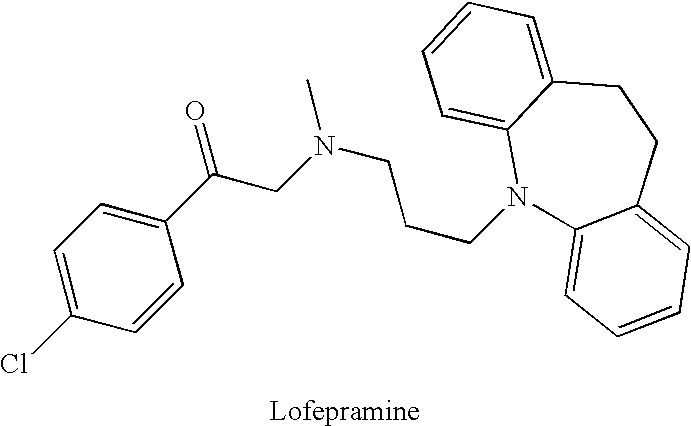Use of Pharmaceutical Compositions of Lofepramine for the Treatment of Adhd, Cfs, Fm and Depression
a technology of lofepramine and composition, which is applied in the field of use of pharmaceutical compositions of lofepramine for the treatment of adhd, cfs, fm and depression, can solve the problems of serotonin reuptake inhibitors, antidepressants tested, and patients' lives are often frequently disrupted, so as to achieve high effectiveness and good tolerated
- Summary
- Abstract
- Description
- Claims
- Application Information
AI Technical Summary
Benefits of technology
Problems solved by technology
Method used
Image
Examples
example 1
[0078]Patient is a 19 year old man with a diagnosis of DSM-IV ADHD. His education was severely impacted by an inability to sustain attention for any length of time and he was also very disruptive in class. His inability to sustain attention was causing difficulty at work. He was referred by his primary care physician. He was commenced on lofepramine 70 mg twice daily. After 1 week his parents noted a significant improvement in his general behaviour and his concentration in particular. The dose of lofepramine was increased to 70 mg three times daily. There was continued improvement, which was sustained for 3 months at which point he decided to stop the medication. Within 48 hours his concentration deteriorated and he was once again in trouble at work. A week later the medication was recommenced and he has now remained well for approximately 4 months. He is performing effectively at work and his parents are happy with the situation.
[0079]A 17 year old boy had been on methylphenidate f...
example 2
[0080]A study was carried out to access the efficacy of lofepramine compared to placebo in 20 adult patients with ADHD at a single study centre. Active treatment was for 3 months. Patients with DSM-IV diagnosis of ADHD were recruited. Patients were assessed using the patient-rated Connors Adult ADH Rating Scales (CAARS). Initially, there was a single blind placebo period between day 0 and week 3, and patients who responded to placebo were withdrawn. Oral administration of lofepramine (140 mg / day) was commenced from week 3 onwards. Patients showing little response to this dose and tolerable side effects were titrated upwards to 210 mg / day and then to 280 mg / day. At the sixth visit at week 12, patients were gradually discontinued by 70 mg decrements over a 4 day period with all medication discontinued by week 14. The results show significant benefit over placebo as assessed by CAARS scores.
example 3
[0081]Forty-four patients meeting the criteria for Chronic Fatigue Syndrome were recruited in a cross-over design. Patients had at least a 6 month history of chronic fatigue syndrome, no co-morbid psychiatric disorder (HADS scale for entry <10), negative for drugs of abuse, normal ECG and had 4 or more of the following symptoms; substantial impairment of short term memory or concentration, sore throat, tender lymph nodes, muscle pain, multi-joint pain without swelling or redness, headaches of a new type, pattern or severity, unrefreshing sleep, post-exertional malaise lasting more than 24 hours. Patients were administered lofepramine at doses up to 210 mg / day over the 26 weeks of the study. Patients were assessed using the FibroFatigue Scale (interview scale) and the CDR battery of cognitive tests (computer based assessment of cognition). Other assessments included HADS and Clinical Global Improvement (CGI). Four CDR assessments and 9 Fibrofatigue assessments were carried out. Data ...
PUM
| Property | Measurement | Unit |
|---|---|---|
| Mass | aaaaa | aaaaa |
| Mass | aaaaa | aaaaa |
| Mass | aaaaa | aaaaa |
Abstract
Description
Claims
Application Information
 Login to View More
Login to View More - R&D
- Intellectual Property
- Life Sciences
- Materials
- Tech Scout
- Unparalleled Data Quality
- Higher Quality Content
- 60% Fewer Hallucinations
Browse by: Latest US Patents, China's latest patents, Technical Efficacy Thesaurus, Application Domain, Technology Topic, Popular Technical Reports.
© 2025 PatSnap. All rights reserved.Legal|Privacy policy|Modern Slavery Act Transparency Statement|Sitemap|About US| Contact US: help@patsnap.com

